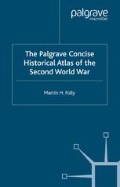Abstract
The Second World War — in its European manifestation — has often been characterised as the final act of a thirty years war for domination of the continent. In this interpretation, the second war followed because the arrangements after the first war failed to settle the issues that caused it; principally the problem of a Germany that was the strongest nation in Europe, but was geographically constrained. The shared ambitions of the Kaiser’s and Hitler’s regimes for expansion in the east at the expense of the Slavs make this theory plausible.
Access this chapter
Tax calculation will be finalised at checkout
Purchases are for personal use only
Author information
Authors and Affiliations
Copyright information
© 2004 Martin Folly
About this chapter
Cite this chapter
Folly, M.H. (2004). The Uneasy Peace. In: The Palgrave Concise Historical Atlas of the Second World War. Palgrave Concise Historical Atlases. Palgrave Macmillan, London. https://doi.org/10.1057/9780230502390_1
Download citation
DOI: https://doi.org/10.1057/9780230502390_1
Publisher Name: Palgrave Macmillan, London
Print ISBN: 978-1-4039-0286-3
Online ISBN: 978-0-230-50239-0
eBook Packages: Palgrave History CollectionHistory (R0)

